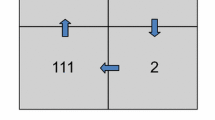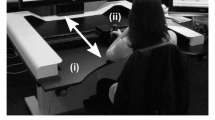Abstract
A distinction in temporal performance has been identified between two classes of rhythmic movements: those requiring explicit timing of salient events marking successive cycles, i.e., event timing, and continuous movements in which timing is hypothesized to be emergent. Converging evidence in support of this distinction is reviewed, including neuropsychological studies showing that individuals with cerebellar damage are selectively impaired on tasks requiring event timing (e.g., tapping). Recent behavioral evidence in neurologically healthy individuals suggests that for continuous movements (e.g., circle drawing), the initial cycle is marked by a transformation from event to emergent timing, allowing the participant to match their movement rate to an externally defined cycle duration. We report a new experiment in which individuals with cerebellar ataxia produced rhythmic tapping or circle drawing movements. Participants were either paced by a metronome or unpaced. Ataxics showed a disproportionate increase in temporal variability during tapping compared to circle drawing, although they were more variable than controls on both tasks. However, two predictions of the transformation hypothesis were not confirmed. First, the ataxics did not show a selective impairment on circle drawing during the initial cycles, a phase when we hypothesized event timing would be required to establish the movement rate. Second, the metronome did not increase variability of the performance of the ataxies. Taken together, these results provide further evidence that the integrity of the cerebellum is especially important for event timing, although our attempt to specify the relationship between event and emergent timing was not successful.
Similar content being viewed by others
References
Zelaznik HN, Spencer RMC, Ivry RB, Baria A, Blume M, Dolansky L, et al. Timing variability in circle drawing and tapping: probing the relationship between event and emergent timing. J Mot Behav. 2005;37:395–403.
Ivry RB, Keele SW. Timing functions of the cerebellum. J Cogn Neurosci. 1989;l:136–52.
Perrett SP, Ruiz BP, Mauk MD. Cerebellar cortex lesions disrupt learning-dependent timing of conditioned eyelid responses. J Neurosci. 1993;13:1708–18.
Medina JF, Garcia KS, Nores WL, Taylor NM, Mauk MD. Timing mechanisms in the cerebellum: testing predictions of a large-scale computer simulation. J Neurosci. 2000;20: 5516–25.
Wing AM, Kristofferson AB. Response delays and the timing of discrete motor responses. Perc Pschophys. 1973;14:5–12.
Collier GL, Ogden RT. Adding drift to the decomposition of simple isochronous tapping: An extension of the Wing-Kristofferson model. J Exp Psychol Hum Percept Perform. 2004;30:853–72.
Ivry RB, Keele SW, Diener HC. Dissociation of the lateral and medial cerebellum in movement timing and movement execution. Exp Brain Res. 1988;73:167–80.
O’Boyle DJ, Freeman JS, Cody FW. The accuracy and precision of timing of self-paced, repetitive movements in subjects with Parkinson’s disease. Brain. 1996;119(Pt 1): 51–70.
Spencer RM, Ivry RB. Comparison of patients with Parkinson’s disease or cerebellar lesions in the production of periodic movements involving event-based or emergent timing. Brain Cogn. 2005;58:84–93.
Desmond JE, Gabrieli JDE, Wagner AD, Ginier BL, Glover GH. Lobular patterns of cerebellar activation in verbal working-memory and finger-tapping tasks as revealed by functional MRI. J Neurosci. 1997;17:9675–85.
Rao SM, Harrington DL, Haaland KY, Bobholz JA, Cox RW, Binder JR. Distributed neural systems underlying the timing of movements. J Neurosci. 1997;17:5528–35.
Robertson SD, Zelaznik HN, Lantero DA, Bojczyk KG, Spencer RM, Doffin JG, et al. Correlations for timing consistency among tapping and drawing tasks: evidence against a single timing process for motor control. J Exp Psychol Hum Percept Perform. 1999;25:1316–30.
Zelaznik HN, Spencer RM, Doffin JG. Temporal precision in tapping and circle drawing movements at preferred rates is not correlated: Further evidence against timing as a generalpurpose ability. J Mot Behav. 2000;32:193–9.
Zelaznik HN, Spencer RM, Ivry RB. Dissociation of explicit and implicit timing in repetitive tapping and drawing movements. J Exp Psychol Hum Percept Perform. 2002;28: 575–88.
Ivry RB, Spencer RM, Zelaznik HN, Diedrichsen J. The cerebellum and event timing. Ann N Y Acad Sci. 2002;978: 302–17.
Spencer RM, Zelaznik HN, Diedrichsen J, Ivry RB. Disrupted timing of discontinuous but not continuous movements by cerebellar lesions. Science. 2003;300(5624): 1437–9.
Trouillas P, Takayanagi T, Hallet M, Currier RD, Subramony SH, Wessel K, et al. International Cooperative Ataxia Rating Scale for pharmacological assessment of the cerebellar syndrome. The Ataxia Neuropharmacology Committee of the World Federation of Neurology. J Neurol Sci. 1997;145:205–11.
Klockgether T, Skalej M, Wedekind D, Luft AR, Weite D, Schulz JB, et al. Autosomal dominant cerebellar ataxia type I. MRI-based volumetry of posterior fossa structures and basal ganglia in spinocerebellar ataxia types 1, 2 and 3. Brain. 1998;121(Pt2):1687–93.
Rub U, Gierga K, Brunt ER, de Vos RA, Bauer M, Schols L, et al. Spinocerebellar ataxias types 2 and 3: Degeneration of the pre-cerebellar nuclei isolates the three phylogenetically defined regions of the cerebellum. J Neural Transm. 2005;112:1523–45.
Pressing J. Error correction processes in temporal pattern production. J Math Psychol. 1998;42:63–101.
Vorberg D, Wing AM. Modeling variability and dependence in timing. In: Heuer H, Keele SW, editors. Handbook of perception & action. San Diego: Academic; 1996. pp 181–262.
Brody CD, Hernandez A, Zainos A, Romo R. Timing and neural encoding of somatosensory parametric working memory in macaque prefrontal cortex. Cereb Cortex. 2003;13: 1196–207.
Leon MI, Shadlen MN. Representation of time by neurons in the posterior parietal cortex of the macaque. Neuron. 2003;38:317–27.
Roux S, Coulmance M, Riehle A. Context-related representation of timing processes in monkey motor cortex. Eur J Neurosci. 2003;18:1011–6.
Bo J, Block H, Clark JE, Bastian AJ. Can cerebellar motor performance be improved by explicit timing information? [abstract online] In: In: 2005 Abstract Viewer/Itinerary Planner. Washington, DC: Society for Neuroscience, 2005, Program no 990.18, 2005.
Blakemore SJ, Frith CD, Wolpert DM. The cerebellum is involved in predicting the sensory consequences of action. Neuroreport. 2001;12:1879–84.
Diedrichsen J, Verstynen T, Hon A, Lehman SL, Ivry RB. Anticipatory adjustments in the unloading task: Is an efference copy necessary for learning? Exp Brain Res. 2003;148:272–6.
Kawato M, Kuroda T, Imamizu H, Nakano E, Miyauchi S, Yoshika T. Internal forward models in the cerebellum: fMRI study on grip force and load force coupling. Prog Brain Res. 2003;142:171–88.
Wolpert DM, Miall RC, Kawato M. Internal models in the cerebellum. Trends Cogn Sci. 1998;2:338–47.
Paulin MG. Evolution of the cerebellum as a neuronal machine for Bayesian state estimation.J Neural Eng. 2005;2:S219–34.
Scott SH. Optimal feedback control and the neural basis of volitional motor control. Nat Rev Neurosci. 2004;5:532–46.
Diedrichsen J, Hashambhoy Y, Rane T, Shadmehr R. Neural correlates of reach errors. J Neurosci. 2005;25(43):9919–31.
Spencer RM, Ivry RB, Zelaznik HN. Role of the cerebellum in movements: Control of timing or movement transitions? Exp Brain Res. 2005;161:383–96.
Franz EA, Ivry RB, Helmuth LL. Reduced timing variability in patients with unilateral cerebellar lesions during bimanual movements. J Cogn Neurosci. 1996;8:107–18.
Kennerley SW, Diedrichsen J, Hazeltine E, Semjen A, Ivry RB. Callosotomy patients exhibit temporal uncoupling during continuous bimanual movements. Nat Neurosci. 2002;5:376–81.
Molinari M, Leggio MG, Filippini V, Gioia MC, Cerasa A, Thaut MH. Sensorimotor transduction of time information is preserved in subjects with cerebellar damage. Brain Res Bull. 2005;67:448–58.
Helmuth LL, Ivry RB. When two hands are better than one: Reduced timing variability during bimanual movements. J Exp Psychol Hum Percept Perform. 1996;22:278–93.
Schlerf JE, Spencer RMC, Ivry RB, Zelaznik HN. The role of the cerebellum in the temporal control of continuous movements. [abstract online] In: 2005 Abstract Viewer/Itinerary Planner. Washington, DC: Society for Neuroscience, 2005. Program no 774.7.
Madison G. Variability in isochronous tapping: Higher order dependencies as a function of intertap interval. J Exp Psychol Hum Percept Perform. 2001;27:411–22.
Author information
Authors and Affiliations
Corresponding author
Rights and permissions
About this article
Cite this article
Schlerf, J.E., Spencer, R.M.C., Zelaznik, H.N. et al. Timing of rhythmic movements in patients with cerebellar degeneration. Cerebellum 6, 221–231 (2007). https://doi.org/10.1080/14734220701370643
Issue Date:
DOI: https://doi.org/10.1080/14734220701370643




